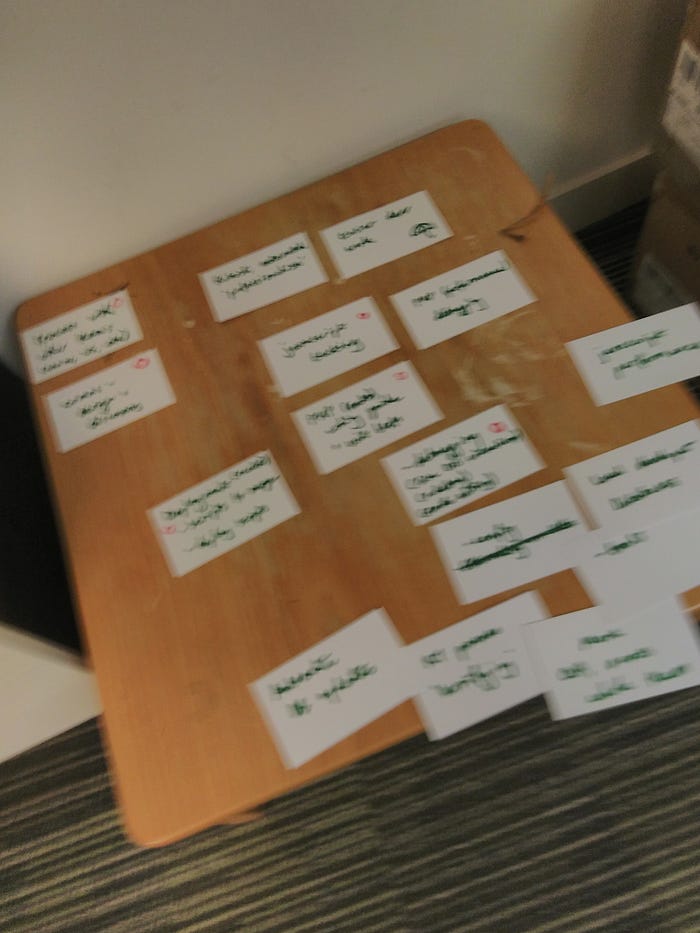IT’S 2019eeeeeeeeeeeeeen. I’m feeling so old that the numbers of a year don’t mean anything to me any more, and could easily be replaced with random-character codes, like airports. Welcome to the year EIGTBD.
It was only a two-day week. My aims were:
- Come back to work feeling relaxed and focused, not diving straight back into the thick of things.
- Pick up reviewing tech (team) strategy from where I’d left off.
Reviewing our tech (team) strategy
I started by getting my head back into things. I wrote up the white cards from our dev session at the end of last year, which had our proposed quarterly focuses scribbled carefully on them. This was the first ‘proper’ dev meet I’ve run in a while, which came out of chats with the developers. It’s too easy to get sucked into sprint work and deliverables, and forget to (or — more realistically — avoid) making time for technology as a whole. Which runs the very real risk of leaving us blindsided.

Deliberately dark and fuzzy, because, ummmm, GDPR?
I really like cards for this process — even more than post-its. Cards don’t bend and curl, or pretend to be sticky then fall off the wall, or inversely get stuck in the wrong place. Cards force you to get a table or a floor and look down from above. Their nature inherently inspires that helicopter view that you need when trying to make out clusters and correlations. With cards, I survey everything. I become as God?
I wrote up a summary set of notes and passed this round the meeting attendees to check accuracy, before sending round the whole team.
But I was still dissatisfied — there were a bunch of suggestions and changes here — all good, all fairly focused — but how did they compare against my intended Roadmap, and my identified objectives? CUE MATRIX SPREADSHEET.
-
Note 1*: Strategy is all about navigation, through SPACE and TIME. That’s why we talk about “Roadmaps” so much, but really any OS map will do. Except for business strategy, SPACE is the “what”, and time is (still) the “when”. Both are important to get a single, coherent route through the problem-space ahead of you.
- SPACE. Where does the work fit in against overall aims and objectives? Does it map to somewhere important or necessary? If not, is the work extraneous, or is the strategy lacking something important?
- TIME. Where does the work for in against timescales? Is it late, early, or on time? If it’s on time, that’s probably a good sign that everyone’s in the right place at the right time. If it’s late or early, is this because something has changed externally requiring a shift in time, or should the work be clamped down (if late) or delayed (if early)?
* Technically, the only note.
-
So my spreadsheet tried to compare our proposed and roadmapped focuses against objectives. But which objectives? I had so many — or at least, enough to make the spreadsheet HORIZONTALLY UNWIELDY. Which is basically structural death.
Confused, I resorted to thinking via Blog Post. I want to use this approach more this year, as I’m generally doing more thinking out loud, and maybe inspired by Steph Gray’s post on blogging too. I think a lot of what I do is still fairly obscure, so I’m going to try just spitting more stuff out there, and if anyone gets something from it, great. #OPENBYDEFAULT
The post didn’t get finished, not yet. Maybe longer-term blogposts are a thing?
Feeling relaxed and focused
Getting everyone back into work at the same time feels like the end of ‘Inception’ when everyone wakes up and finds themselves in a strange place, and everyone’s trying to remember where and who they were at the start of the film. The first few days back are a good time to adjust slowly. We kicked our sprint planning meeting back to the afternoon so that we could spend the morning re-orienting ourselves. The prep work done last year for lining up tasks in the meeting worked well though.
Tip to self: Always leave something in an unfinished, yet easy to pick up state when going away, to help make re-entry easier.
Looking at the calendar ahead, next week could be busy, so it’s important to keep that in mind as the plans for the immediate future are set up. I didn’t give myself anything too onerous in the sprint, and will be on more of a support and PO role than a dev one.
So far, pretty good. But then, it’s easy to say that after only 2 days…
Originally published at Graham’s Weeknotes.
